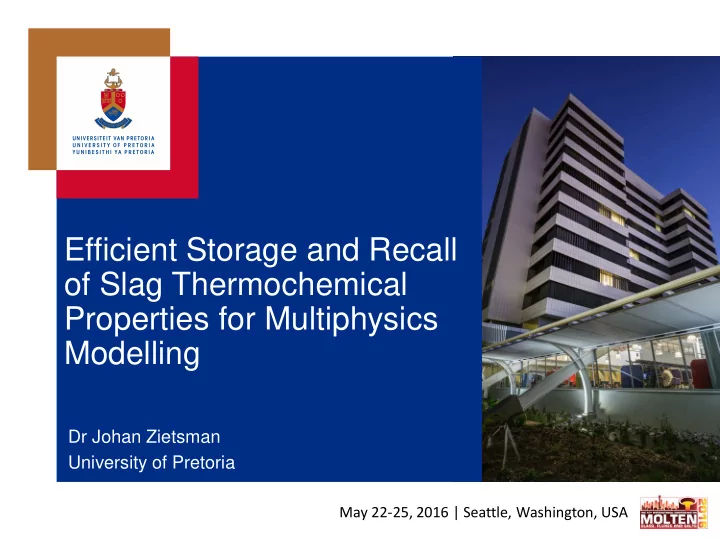

Efficient Storage and Recall of Slag Thermochemical Properties for Multiphysics Modelling Dr Johan Zietsman University of Pretoria May 22-25, 2016 | Seattle, Washington, USA
Background 2
Ilmenite Smelting 3
High-titania Slag Predominantly Single Phase 4 (Pistorius and Coetsee, 2003)
Combination of Factors Heat Transfer Fluid Flow Thermochemistry 5
Concepts 6
Comprehensively Describing Pyrometallurgical Processes Multiphysics Thermochemistry Solver Calculator (OpenFOAM) (FactSage, ChemApp) Heat transfer Equilibrium calculation Fluid flow Heat capacity Mass transfer Enthalpy Electromagnetics Viscosity Density 7
Computational Cost 45 Al 2 O 3 -CaO-MgO-SiO 2 40 Average Equilibrium Calculation 35 30 Duration (ms) 25 20 15 10 y = 0.0717x 4.4821 R² = 0.9132 5 0 1 2 3 4 5 Number of System Components 8
Computational Cost 1000 100 Iteration Duration (h) 10 1 1e4 cells 1e5 cells 0.1 1e6 cells 0.01 0.001 0 2 4 6 8 10 12 Number of System Components 9
Comprehensively Describing Pyrometallurgical Processes Multiphysics Thermochemistry Solver Calculator (OpenFOAM) (FactSage, ChemApp) Heat transfer Equilibrium calculation Fluid flow Heat capacity Mass transfer Enthalpy Electromagnetics Viscosity Density 10
Comprehensively Describing Pyrometallurgical Processes Multiphysics Thermochemistry Thermochemistry Solver Accelerator Calculator (OpenFOAM) (gtc) (FactSage, ChemApp) Heat transfer Equilibrium calculation Fluid flow Heat capacity Mass transfer Enthalpy Electromagnetics Viscosity Density 11
Phase fractions Temperature (K) Phase element fractions Thermochemistry Element mole Enthalpy Accelerator fractions Heat capacity (gtc) Density Total amount Viscosity (mol) 12
Previous Work 13
Previous Work • Not a new problem • Aluminium casting examples • Up to 4 system components • Geometric approaches • Limited use of thermochemistry theory • No application to extractive metallurgy 14
Method 15
Decisions • Start with binary and ternary systems • Use a geometric approach • Apply thermochemistry theory to – simplify and accelerate calculations; – minimise dimensionality of geometries; and – minimise storage and memory requirements. • Implement prototype in Python 16
Geometric Approach • Phase diagrams describe thermochemical behaviour – Binary – Ternary • Phase diagrams are also geometric systems, consisting of: – Points – Phase region boundaries (curves, surfaces) – Phase regions (volumes) 17
Geometric Approach 18
Geometric Approach 19
Geometric Approach 20
Geometric Approach 21
Geometric Approach 22
Geometric Approach 23
Geometric Approach Simplifies the calculation of • Phase fractions • Phase compositions 24
Thermochemistry Theory Gibbs Phase Rule 𝑔 = 𝑑 − 𝑞 + 2 At constant pressure: 𝑔′ = 𝑑 − 𝑞 + 1 Classify phase regions 25
Thermochemistry Theory Gibbs Phase Rule 26
Thermochemistry Theory Lever Rule • Reduce dimensionality 27
Thermochemistry Theory Lever Rule 28
Thermochemistry Theory Lever Rule • Reduce dimensionality • Calculate phase fractions • Binary systems: – 2-phase regions • Ternary systems: – 2-phase regions, 3-phase regions • c-component systems: – 2- phase regions, …, c -phase regions 29
Thermochemistry Theory Lever Rule 30
Thermochemistry Theory Lever Rule 31
Implementation Python • Positive: – Extensive mathematical and numerical libraries – Simple language – Access to ChemApp – Rapid prototyping • Negative: – Computationally slow • Will transfer algorithms to Fortran 32
Thermochemistry Accelerator (gtc) Geometry Geometry Calculator Constructor (gcalc) (gcon) Geometric Representation Database (gdb) 33
Equilibrium Calculation New Region gtc 4 1 5 11 7 Multiphysics gcalc gcon Thermochemistry 12 6 Solver Calculator 2 8 10 3 (OpenFOAM) (FactSage, ChemApp) gdb 9 1. request equilibrium result 7. construct geometry 2. request geometry 8. provide geometry 3. request geometry construction 9. store geometry 4. request equilibrium results 10.provide geometry 5. do equilibrium calculations 11.calculate equilibrium 6. provide equilibrium results 12.provide equilibrium result 34
Equilibrium Calculation Stored Region gtc 1 4 Multiphysics gcalc gcon Thermochemistry 5 Solver Calculator 2 3 (OpenFOAM) (FactSage, ChemApp) gdb 1. request equilibrium result 2. request geometry 3. provide geometry 4. calculate equilibrium 5. provide equilibrium result 35
Results 36
Accelerator Performance • Binary system (Al 2 O 3 -CaO): – 20x faster ChemApp – Negligible deviations from ChemApp results • Ternary (Al 2 O 3 -CaO-SiO 2 ): – 15x faster than ChemApp – Negligible deviations • Fortran implementation – Can be 10x to 1000x faster than Python – Possible 150x to 20000x acceleration – Multiphysics-thermochemistry integration can become feasible 37
Next Steps 38
Future Plans • Add Cp and H • Develop generic algorithm for c- component systems • Develop multicomponent, multiphase solver in OpenFOAM • Develop test cases – Freeze lining – Slag-alloy reduction interactions 39
Thank you
Recommend
More recommend